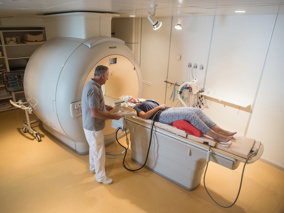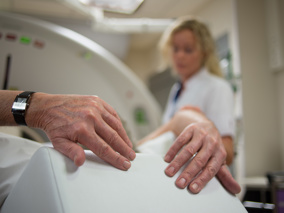Sarcomas
Sarcomas are malignant tumors in the soft tissues of the body. Think, for example, of muscles, nerves, fat, blood vessels, cartilage, bone and the tissue between the organs. That is why sarcomas are also called soft tissue tumors. Some sarcomas grow slowly and others grow quickly. At the Netherlands Cancer Institute, we treat all sarcomas, except for sarcomas in the bone.
On this page you can read more about the symptoms, examinations and treatments for sarcomas.
Learn more about sarcomas
Causes of sarcomas
Sarcomas are rare. They mainly occur in children and in adults over 40 years of age. Little is known about how these soft tissue tumors develop. Long-term exposure to pesticides (such as pesticides), previous radiation and chronic lymphoedema can also influence the development of soft tissue tumours. Sometimes heredity plays a role.
Symptoms of sarcomas
Sarcomas usually only cause symptoms after a longer period of time. They lie between other tissues and therefore often press on organs, blood vessels or nerves at a late stage. Sarcomas most often occur in the legs (usually upper legs), the chest and abdominal wall, the arms and the head and neck area:
- In the legs: 40% (of which three-quarters of the thighs)
- In the chest and abdomen: 30%
- In the arms: 15%
- In the head and neck area: 15%
Are sarcomas benign or malignant?
Another word for a sarcoma is a malignant soft tissue tumor. Malignant means that it is cancerous. You may also have a benign soft tissue tumor. Then it is not called sarcoma.
Benign soft tissue tumors are very common. The most common are the lipoma (the fat lump) and the fibroma. There is also an intermediate group of 'borderline' tumors. These are tumors that can grow aggressively locally, but cannot metastasize. Examples include the atypical lipomatous tumor (also called well-differentiated liposarcoma) and desmoid-type fibromatosis.
Types of sarcomas
Sarcomas in the abdomen
Retroperitoneal sarcomas
Retroperitoneal sarcomas are a special group of soft tissue tumours. These tumors originate in the retroperitoneum (a space at the back of the abdominal cavity, outside the organs) and therefore go unnoticed for a long time.
Because they do not originate from an organ itself, they can continue to grow unnoticed. Only at a late stage do they cause complaints, usually due to the displacement of the organs around them. Retroperitoneal sarcomas are therefore often discovered by chance, for example during imaging tests performed for another reason.
Liposarcomas
The most common sarcoma in the abdomen is liposarcoma (60-65%). This tumor consists of fatty tissue. A distinction is made between the less aggressive (well-differentiated) liposarcomas and the much more aggressive (poorly differentiated) liposarcomas.
Gastrointestinal stromal tumors
Gastrointestinal stromal tumors (GIST) are a fairly common type of sarcoma of the abdomen. The tumor originates in the wall of the intestine. Yeasts can occur throughout the gastrointestinal tract. In most people, the tumor is in the stomach (60%).
A GIST can cause complaints. For example, you may experience abdominal pain during or after eating. Sometimes bleeding occurs. But often a GIST is discovered by accident, without anyone having any symptoms. Yeasts can behave very differently. Sometimes the tumor remains small and does not change for years. Sometimes it grows quickly and can metastasize to other places in the body.
Other sarcomas in the abdomen
Another common tumor in the abdomen is leiomyosarcoma (20-30%). This tumor usually arises from a vascular wall. Other less common abdominal sarcomas include the undifferentiated pleiomorphic sarcoma, the malignant peripheral nerve sheath tumor, and the solitary fibrous tumor.
Borderline soft tissue tumor
Desmoid-type fibromatosis
Desmoid-type fibromatosis is a non-malignant tumor. This tumor most closely resembles troubled scar tissue. We don't know exactly how a desmoid is formed. The tumor is often found in a (surgical) scar or after other forms of injury.
Hormones can affect growth. That is why we see the tumor relatively often during or after pregnancy. He is often in the scar of a caesarean section. There is no risk of metastases of a desmoid-type fibromatosis. But it is difficult to predict how the tumor will behave.
Patients can be roughly divided into three groups. In the first group, the tumor grows first, but then shrinks on its own. In the second group, the tumor remains the same for a long time. In the third group, the tumor continues to grow.
When making the diagnosis, we do not yet know which group someone falls into. That is why we first monitor the tumor closely with an ultrasound or MRI, without treatment. If the tumor does grow or if someone has a lot of complaints, treatment may be necessary. The treatment is then sometimes with medication and sometimes with surgery.
Atypical lipomatous tumor
An atypical lipomatous tumor (ALT) is also called a well-differentiated liposarcoma. This is a lipoma (fat tumor) that can still grow. The tumor often feels like an elastic swelling. It is usually under the skin or in a muscle. These fat tumors cannot metastasize.
Sometimes a differentiated liposarcoma is located in the abdomen (in the retroperitoneum). Here they are more dangerous and that is why the attending physician usually opts for surgery.
Sarcomas that develop after previous radiation
About half of all patients with cancer receive radiation treatment. In less than 1% of these patients, a sarcoma can develop as a result. This can happen from 2 to 20 years after the last radiation treatment. Of this group, 70% are women.
These are often angiosarcomas of the breast that develop after radiation in breast cancer. Angiosarcoma is a very aggressive tumor. Treatment usually consists of chemotherapy along with extensive surgery.
People who have had radiation because of lymphoma can also get a sarcoma after radiation. This group is likely to shrink in the future. This is because doctors now use medication more often instead of radiation for lymphoma.
Dermatofibrosarcoma protuberans – soft tissue tumor of the skin
Dermatofibrosarcoma protuberans (DFSP) is a slow-growing tumor of the skin. The DFSP mainly occurs in people between the ages of 20 and 40. A DFSP can grow locally aggressive and wispy in a spy.
The tumor has a high chance of recurrence. This means that there is a high chance that the tumor will come back after surgery. That is why the attending physician removes the tissue around the tumor. Then the tumor almost never returns. The plastic surgeon often has to make a reconstruction after the operation.
DFSP almost never metastasizes. There is only a small part that can metastasize. These tumors look more malignant under the microscope.
Waiting
We want to inform you as well as possible about the waiting time per condition. We do this based on a prognosis of the current waiting list. The waiting time can vary from patient to patient for various reasons. Your attending physician will give you more information during your outpatient consultation.
-
7 days
First appointment
This is approximately how long it will take until you have your first appointment
-
7 days (max)
New patients can come to the clinic every Tuesday. This clinic is available for rapid diagnostics as well as second opinions. Your wait time depends on the moment of referral. Most people can come in the following Tuesday.
-
7 days
Second opinion
New patients can come to the clinic every Tuesday. This clinic is available for rapid diagnostics as well as second opinions. Your wait time depends on the moment of referral. Most people can come in the following Tuesday.
 nl
nl






